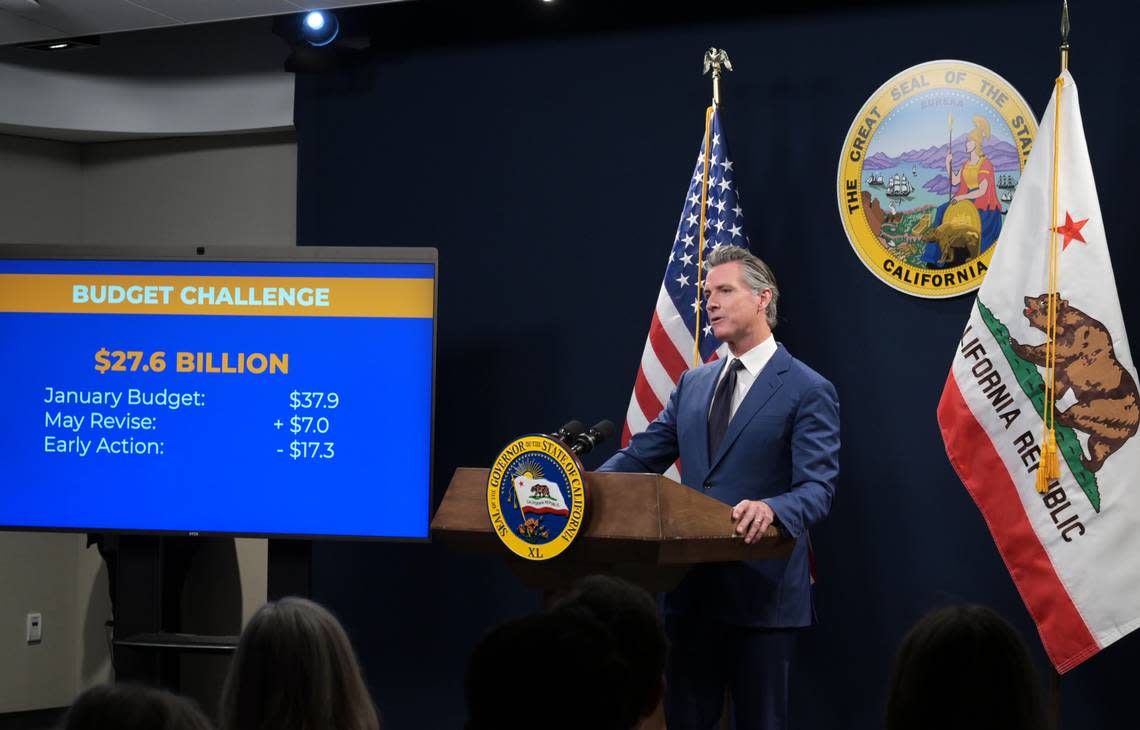Could high interest rates, high prices hurt Newsom’s budget outlook for California?

- Oops!Something went wrong.Please try again later.
High interest rates. Stubbornly high prices. Wildfires, China-Taiwan tension. Maybe even a recession.
All those risks are cited in Gov. Gavin Newsom’s May budget revision’s economic outlook. While Newsom boasts that the state’s economy is healthy and growing, his budget offers a more sobering look at what may be ahead for California.
The budget does not forecast a recession, and echoes projections from private forecasters that the state’s economy should continue to grow at a slow to moderate pace.
But, the governor’s budget warns, “if inflation takes longer to cool and interest rates remain high for longer than projected in the May revision,” there’s economic trouble lurking.
“This could deepen the expected economic slowdown,” the budget outlook says of high interest rates and steady inflation, “and push the economy into a mild recession with steeper declines in investment and interest-sensitive consumption.”
A slowing economy could mean less revenue coming into the state treasury. Already, California has had to revise its deficit forecast as it collected $7 billion less this spring than projected in January.
Newsom and legislative leaders have until June 15 to agree on a balanced budget for the fiscal year that begins July 1.
Will interest rates fall?
Interest rates and inflation are the potential economic threats.
“Immediate risks to the forecast remain driven by persistent inflation and elevated interest rates,” the budget forecast says.
“The current high interest rate environment could hamper economic activity by more than predicted, “ it says. Higher interest rates can mean more cautious lending as well as wary consumers more reluctant to spend.
The Federal Reserve has pushed its key interest rate up 11 times since March 2022. The rate’s been steady since last summer, and the Fed had sent strong signals last year that it would begin dropping the rate by now.
Instead, it remains the same, keeping interest rates on 30-year fixed mortgage rates around 7% and credit card interest rates at high levels.
The Fed wants the annual rate of inflation to sink to 2%. Instead, the increase in personal consumption expenditure inflation figure, which the Fed eyes closely, has been higher–2.7% for the 12 months ending in March.
The Fed’s inaction on rates is the “biggest near-term threat to the forecast,” the budget outlook says.
Current rates “could curtail interest-sensitive consumer spending and business investment, which would hamper economic activity more than expected.,” according to the forecast.
Will more jobs be available?
There are other cautionary signs.
While growth in the labor force has been solid, only about three-fourths of the 1 million people who left the labor force at the start of the COVID pandemic four years ago are back.
The state’s unemployment rate in March, the latest data available, was the highest in the nation at 5.3%, though there’s no evidence of big layoffs and job growth was up. As more people enter the labor force and look for work, and some have trouble finding employment, the rate stays up.
The national rate was 3.8%. The budget forecasts the California rate should stay at 5.3% through the first half of next year “as tight financial conditions continue to soften the labor market before moderating as credit conditions ease.”
The outlook offers a list of other risks: “An escalation of tensions between China and Taiwan,” it says, could be a problem because of the state’s ties to that region.
The budget also forecasts economic problems if there are “more frequent extreme weather events such as wildfires, drought and floods.”
And it suggests more potential perils: “The challenges of an aging cohort that is becoming an increasingly larger share of the total population, declining migration inflows, lower fertility rates, ongoing stock market volatility, high housing and living costs, and potentially worsening income inequality.”

